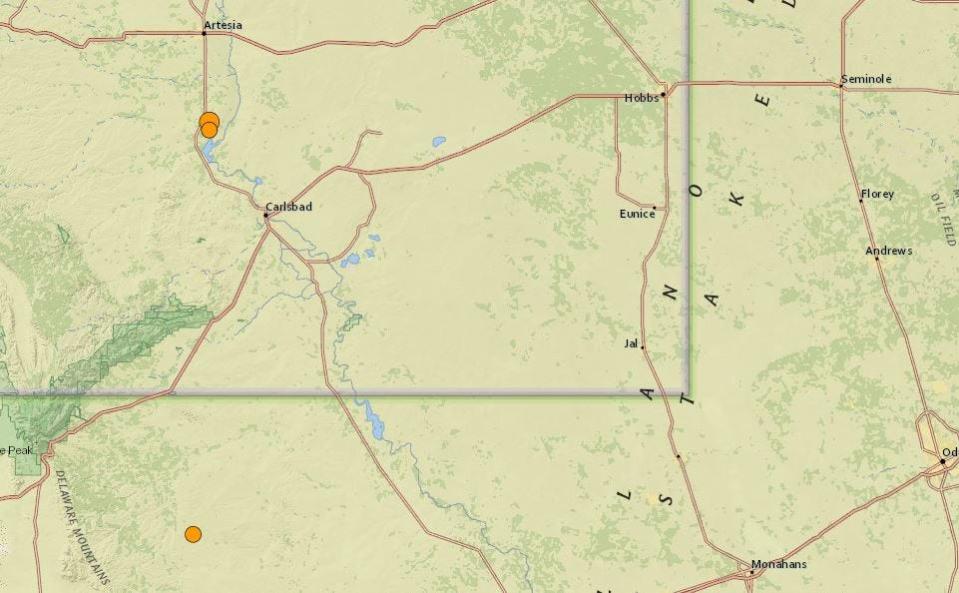Homes shake and dogs bark as earthquake hits Friday morning near Carlsbad
Carlsbad was awoken by an earthquake at about 2:47 a.m. Friday morning, the largest reported so far this year throughout the Permian Basin in southeast New Mexico and West Texas.
The magnitude 4 quake hit about 9 miles south of Atoka in Eddy County, near Brantley Lake, according to data from the U.S. Geological Survey. M 4 earthquakes are considered minor on the Richter Scale, according to the USGS, and are often felt by people.
It was followed by an M 2.8 in the same area, minutes later.

More: Texas blocks oil and gas wastewater wells amid earthquakes. What is New Mexico doing?
There are about 10,000 such earthquakes a year, the agency reported, and property damage usually doesn’t occur until earthquakes reach M 5 or higher.
The latest earthquake was the largest magnitude event of the year in the Permian Basin region, including along the Texas-New Mexico state line south of Eddy and Lea counties.
Twenty-eight earthquakes of an M 3 or higher were reported in the area so far this year, mostly in Texas near Pecos and Mentone.
More: Southeast New Mexico shook by early morning earthquake reported in West Texas oilfield
The only other earthquake reported within New Mexico’s border this year was an M 3.4 reported Feb. 2 in New Mexico about 8 miles northeast of Jal.
During the same time period in 2023, Jan. 1 to Feb. 23, there were only 19 earthquakes at M 3 or higher, nine less than this year, with just one in New Mexico, reported at M 3.3 about 21 miles southeast of Malaga.
The Permian’s largest earthquake last year was a 5.2 reported Nov. 8 near the Texas-New Mexico border at Coalson Draw, Texas.
More: Can smaller tremors protect New Mexico from oil and gas earthquakes in Permian Basin?
Eddy County Emergency Manager Jennifer Armendariz said her office hadn’t heard any reports of damage, although she received several reports from concerned residents who said they felt the quake.
She also pointed to an M 2.8 quake near Whites City also overnight.
“No one has called in any damages from them. We haven’t seen anything visibly,” Armendariz said. “Sometimes you can feel even the smaller ones.”
More: Here's what to know about New Mexico's latest efforts to reuse oil and gas wastewater
Emergency Management investigates quakes, Armendariz said, driving out to the area around an epicenter to inspect visually for damages.
“It’s pretty rural areas usually. This one was closer to the city,” she said. “They sure seem to be coming more and more.”
When the latest tremblor hit, Facebook lit up with Carlsbad residents asking if others felt the shaking and describing their experiences.
More: Shaky Ground: The link between the Permian Basin's fossil fuel industry and earthquakes
“My windows rattled and woke me up. It seems like we've been having more and more of these. Someone said it was from Fracking,” said Deena Cantrell of Carlsbad.
Torie Harges of Carlsbad said the quake rattled her house and upset her pets.
“Shook my whole house and made my dogs bark,” she posted.
More: Fault lines at Texas-New Mexico border complicate earthquakes linked to waste water disposal
Increasing tremors tied to expanded oil and gas production
Earthquakes throughout the Permian Basin were tied to growing oil and gas operations in the area, and the use of disposal wells for oilfield wastewater, known as “produced water.”
Produced water is brought to the surface with crude oil and natural gas, heavy in brine and toxic chemicals, usually pumped back underground to the formation it came from.
This can add pressure to deep, underground rock and cause them to shift which in turns can cause shaking at the surface in the form of earthquakes.
Oilfield quakes are tracked by the New Mexico Oil Conservation Division which in 2021 enacted regulations to reduce water injection volumes or shut-in disposal wells based on their proximity or the magnitude of the quakes.
Acting Director Dylan Fuge said the agency’s County-Line Seismic Response Area (SRA), along the border between Eddy and Lea counties, did see some improvement since the regulations took effect.
He said the OCD was studying the potential use of shallower disposal wells in that area, that might not stimulate the deep rock formation known to cause earthquakes.
“In the county line SRA, it was clear certain deep disposal wells were affecting basement rocks and driving seismicity,” Fuge said. “I think we need to be equally careful when looking at shallow disposal. There is no sort of perfect solution.”
Anyone in Eddy County who feels an earthquake or sees resulting damage was asked to call Eddy County Emergency Management at 575-885-3581 or message the agency's Facebook page at https://www.facebook.com/EddyCountyOEM.
Adrian Hedden can be reached at 575-628-5516, achedden@currentargus.com or @AdrianHedden on the social media platform X.
This article originally appeared on Carlsbad Current-Argus: Earthquake reported outside of Carlsbad near Atoka Friday morning

